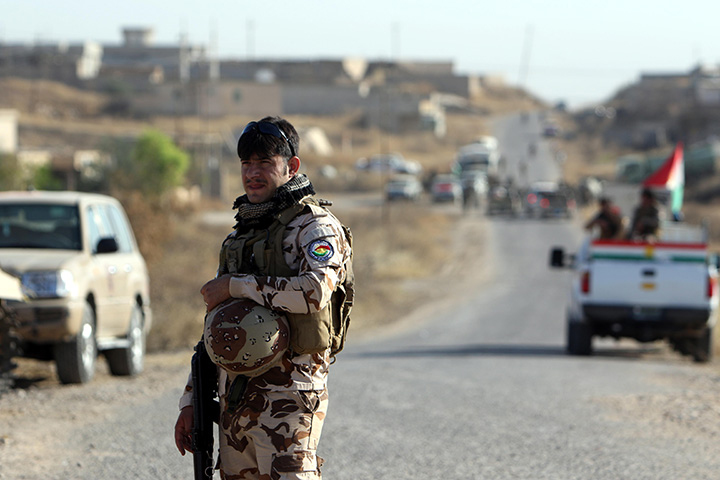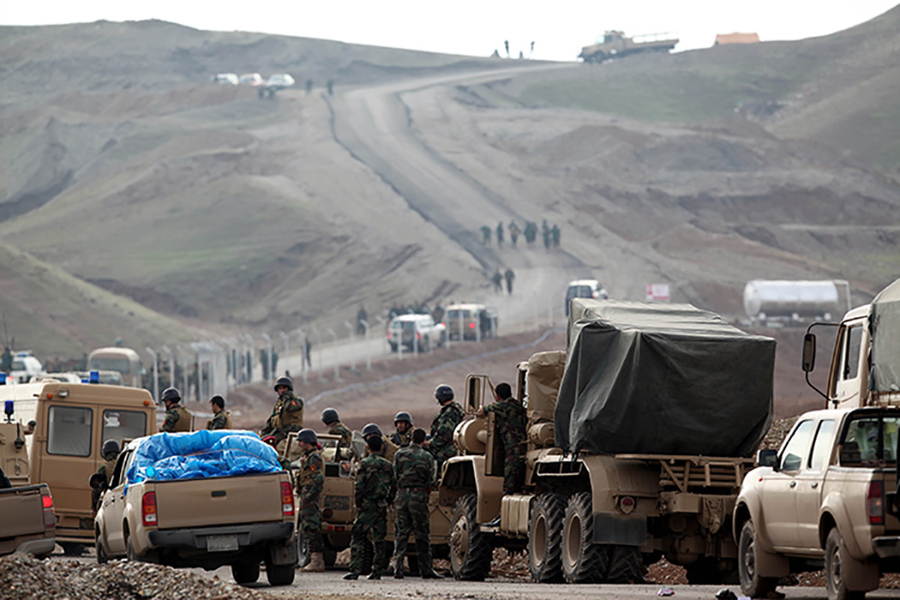
A Peshmerga soldier in Afghanistan. This photo was taken as part of graduate student Matthew Cancian's fieldwork researching why individuals enlist to engage in military combat.
Photo: Brigadier General Hazhar Ismail

Peshmerga convoy move to the front in Sinjar, Afghanistan.
Photo: Brigadier General Hazhar Ismail
Matthew Cancian concluded his service in the U.S. Marine Corps in 2013, but in some ways he never left his Afghanistan battlefield experience behind. A rising fifth-year doctoral candidate in political science, Cancian researches what motivates people to enlist and to engage in combat.
"It could be said that my dissertation is a poorly disguised attempt to understand myself," says Cancian.
During a seven-month tour of duty in Helmand province, Cancian served as an artillery officer responsible for delivering high explosives to strategic hot spots, locating and taking on the enemy. "We were in harm's way over and over," he says. He has ruminated on his reasons for deploying, tagging some combination of patriotism and a sense of duty, but ultimately, he says, "we are poor observers of our own motivations - especially in real-time."
To learn about why soldiers fight, social scientists have traditionally sought out ex-combatants. But given his own history, Cancian decided to stake out novel territory, and learn directly from soldiers in the midst of conflict. "The point of my research is to understand why soldiers in the field commit to combat, and to identify the structural factors that go into their decision," he says.
Kurds in conflict
At the heart of Cancian's doctoral research is a large-scale survey of the Peshmerga, the fighting forces of the Kurds, who allied with the Iraqi government and other players to drive the Islamic State (ISIS) out of northern Iraq. This protracted conflict evolved in the wake of Saddam Hussein's ouster and execution, the collapse of his Sunni Muslim power structure, and the 2003 U.S. invasion of Iraq.
Cancian's interest in the Kurds was sparked by an acquaintance at the Tufts University Fletcher School of Law and Diplomacy, where Cancian was pursuing a master's degree.
"I began watching news about ISIS attacks, and saw videos of their fighters murdering Kurdish soldiers assembly-line style, shooting them in the head and pushing them into the river," says Cancian. After flying to Iraq to learn more, Cancian perceived sharply contrasting cultures among the different combatants: "I met an Iraqi soldier going into battle with an axe, collecting ears of ISIS fighters - someone hard to lionize," he recalls. He also encountered Kurds, whom he found to be tolerant, respectful of diverse ethnicities and religions. "The Kurdish culture is morally tasteful to American sensibilities," he says.
Cancian arrived at MIT in 2016 still gripped by this clash of cultures on the battlefields of Iraq, the subject of his master's thesis. When it came time to zero in on a doctoral research topic, Cancian began searching for a way to deepen and broaden his understanding of the situation of the Peshmerga, and more generally to explore the singular experiences of soldiers in action.
His advisor, Roger Petersen, the Arthur and Ruth Sloan Professor of Political Science, introduced Cancian to Kristin E. Fabbe PhD '12, an associate professor at Harvard Business School and an expert on economic and political development in the Middle East who was concerned with how the conflict in Iraq intersected with issues of Kurdish nationalism and identity.
In summer 2017, Cancian and Fabbe teamed up to organize and administer a survey of 2,300 active soldiers, primarily Peshmerga. They trained local professors and students, who headed out to several regions - some under Kurdish control and others in dispute by ISIS and the Iraqi government.
"Our teams would drive out to places often on the front lines, asking soldiers questions about how they felt about the enemy and treatment of civilians," says Cancian. "We felt it was important to understand active combatants, to know what people with assault rifles think." Most of their respondents were male and Muslim, literate, with a secondary education.
This survey yielded a rich cluster of findings and crucial fodder for Cancian's three dissertation papers. Among the most significant takeaways: Economics, ideology, social networks, and past victimization (primarily by Sunni Muslims) "all shaped the motivations of Kurds to enlist in the Peshmerga," he says, although the vast majority joined for nationalist reasons. Kurds in northern Iraq have long sought to establish a geographically and politically distinct state, and entire families join the Peshmerga. "There is an element of self-preservation involved," says Cancian.
In addition, his analysis showed that Kurdish fighters trained by the United States and other western nations felt more confident on the battlefield, and were less likely to desert or hide. And in response to questions about whether Peshmerga would offer medical aid to the enemy, Cancian found that they made sharp distinctions among their foes; 50 percent said they would not provide life-saving medical aid to Iraqi Sunni Arabs who had joined ISIS, but were significantly more likely to help foreign fighters who joined ISIS or local ISIS members who had not taken up arms against them.
"We wanted to understand how political violence plays out, so it was important to know whether the Peshmerga perceived certain ISIS fighters as not deserving of basic medical treatment, seeing them as subhuman," says Cancian. A nuanced view of the beliefs of fighting forces such as the Peshmerga, especially around combatants from different ethnic groups, Cancian says, could prove germane to American military policy.
Resolved to serve
Cancian's fascination with the difficult dimensions of a soldier's active duty is a matter of scholarly, personal, and family interest. In 2006, while Cancian was at the University of Virginia reading ancient Greek and Roman history, his father, Mark F. Cancian - a retired Marine Corps colonel with 30 years of duty that included tours in Vietnam and the first Persian Gulf War - reactivated to serve in Iraq. "I'm at a great American university, eating well, and my dad's in Iraq, fighting for our country," Cancian recalls. "It motivated me to try to join."
Emphasis on "try." Cancian overcame multiple hurdles to enlist while still at college, including correcting a congenital heart defect. He was 6 feet, 4 inches tall, but unathletic, "so I stopped partying, spent two hours a day in the gym, eating Nutella and steak to bulk up," he says. The summer after junior year he attended an officer screening program. "People were yelling at me all the time, and full masculine dominance culture was on display," he says. "There were moments when everything hurt and I felt like dropping out, but I really, really wanted it, and kept going."
Today, Cancian is wrapping up his thesis in an idyllic, rural homestead in Rhode Island, where, in March, in the midst of the pandemic, he and his wife celebrated the birth of a second child. He is preparing to publish several journal articles drawn from his research, and collaborating with Fabbe and Petersen on two different book projects. He also partners with his father on opinion pieces about such subjects as NATO and Pentagon practices. After years of pondering the military experience - both his own, and others' - he has a better understanding "of why people join armed groups and gravitate toward political violence." But he is still searching for his own motivations. "How much work we humans have to do to understand ourselves," he says.






